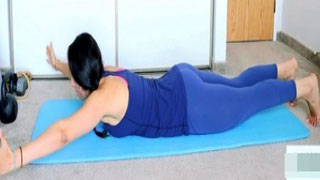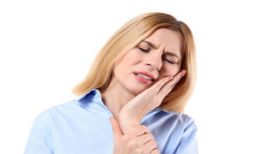Are you still struggling with persistent neck and shoulder pain? This is usually caused by tension in the levator scapula muscle and/or the superior trapezius muscle. Today, let's solve this problem through self myofascial release and exercises done at home.
How do your neck and back muscles connect
Reasons for neck pain
Should you stretch your neck muscles?
Exercise to relieve neck pain (limited to dumbbells and resistance bands only)
Practice (and other things) to avoid this situation from happening
The human body is an interconnected unit. We cannot view the body in fragments. What happens at the top will affect the bottom.
To address the causes of neck pain, we need to adopt a comprehensive approach. Especially if you don't want it to come back. And, I think you would agree that it's frustrating when the pain reappears after only a few minutes of relief.
If you stretch your neck every time you feel pain, it will make the pain worse, and I will also explain why this happens. Now, please don't rush to stretch your neck. There are more effective and safer mitigation methods available.
Neck and upper back muscles
The muscles that connect the cervical spine
Scapular levator muscle, rhombus muscle, trapezius muscle, sternocleidomastoid muscle, scalene muscle, deep cervical flexor muscle
Reasons for neck pain
The most common causes of neck pain may be related to posture, muscle stiffness or strain, weakness, or intervertebral discs.
Round shoulders and forward leaning head posture.
Stiffness and trigger point of levator scapula muscle
Deep flexor muscle weakness
Pressure, bacterial strains, and disc issues
It is important to address any imbalance or misalignment in the neck. Because this will have an impact on the power chain (lower back, knees, ankles).
How does neck pain cause lower back pain?
If the cause of neck pain is related to improper posture, such as rounded shoulders and forward tilting of the head, it can lead to pelvic eye reflex
The pelvic eye reflex is a great example of how the upper and lower bodies connect and influence each other. The pelvic girdle and lower body will respond to the position of the head through pelvic eye reflex.
When the head begins to transition forward (head forward posture), the pelvis also moves forward and rotates forward.
This can precisely adjust the center of gravity of the body. Head dysfunction can lead to lower back dysfunction.
Therefore, if you have taken all measures to repair pelvic tilt through stretching and massage therapy, and the pelvis continues to rotate forward, why not check your neck and shoulders?
Take a photo of yourself standing with one side of your body facing your phone. Do not attempt to fix anything, as you want to check your 'default' posture and observe if your head is moving forward and your shoulders are rounded.
Release, extension, and exercise of levator scapula muscle
Should you stretch your neck muscles?
If the pain you experience is around the neck and radiates downwards to the upper back, the muscles involved will be the levator scapula, rhombus, and trapezius.
The following step-by-step article will show you how to release the trapezius muscle. Please make sure to check after this article. If the pain is so severe, please follow the release instructions below and skip today's stretching exercise.
Stretching of the superior trapezius muscle
Pull your head down or to one side to stretch your neck
Stretching of levator scapula muscle
Place one hand behind your back, tilt your head diagonally, and place your ears close to your shoulders. Gently apply pressure with the other hand to increase stretch, targeting the levator scapula muscle.
Self myofascial release surgery
Sometimes, the pain in the levator scapula or neck is very severe, and stretching can exacerbate the pain.
In this case, when pain occurs, persist in releasing the trigger point from the myofascial release rather than stretching.
I strongly recommend that you first perform the following actions:
Firstly, try to relax as much as possible. Take a deep breath and relax your shoulders.
Then, grab a massage ball (or you can do it with 2-3 fingers or a tennis ball), lean against the wall, and first place the ball on the chest muscles.
Afterwards, you can also stretch your chest and front shoulders. I know you may be thinking... okay, I don't have chest pain. But... relieving chest tightness that may cause scapular extension is very important.
Many times, this alone can solve pain (if the pain is caused by muscle tension).
Release any tension around the area (front shoulders and chest).
When the back muscles try to pull the head back to a neutral position, chest tightness can cause neck and upper back pain.
So why not address the root cause of the problem instead of elongating and stretching the back or neck muscles, right?
If you have round shoulders, you need to exercise them almost every day to unlock them. Just be patient and consistent.
I have successfully used a massage ball to release chest muscles, immediately relieving neck and upper back pain.
Then, place the ball in the scapular levator muscle area and start rolling it along one side of the neck (avoiding the spine).
When you reach the soft area that feels like a trigger point, press the ball more. You can perform this operation with your fingers, or lie down and have someone gently press it.
Roll the ball from the back to the lower part of the trapezius muscle. Then slowly roll the ball up and down.
Make sure you stay on top of your muscles. Do not roll on the spine.
Sometimes I feel one side tighter than the other. Don't forget to relax and let the ball penetrate deep into the muscle tissue.
Another great practice is Superman practice.
Lie face down on the mat. Extend both arms and raise them. Make sure you haven't shrugged.

How to avoid neck and upper back pain
Neck pain can occur at any time. Sometimes just sleeping in the wrong position can lead to this situation. I have experienced this many times before.
I strongly recommend using my trapezius muscle control as it will help you achieve long-term relief when you apply these techniques and corrective exercises.
Here are some other suggestions you can follow.
To avoid chronic neck pain caused by all the functional impairments I explained above, I suggest that in addition to self myofascial release and exercise, you should also avoid the following:
Avoid sit ups. Spinal curvature can exacerbate rounded shoulders. This is the opposite of the exercise I showed you above (actually completely opposite to sit ups). There are many methods to train the abdominal and deep core muscles.
Sit in the correct posture to avoid weakening the back stabilizer and maintain consistent posture.
Don't sit lazily texting or using your phone, instead bend your arms at a 90 degree angle. Look straight ahead. Raise your arms and elbows to one side of your abdomen to keep your eyes elevated and avoid bending your neck.
Pressure and neck pain
One of the causes of neck pain is actually pressure. If your lifestyle is full of stress, it can affect your posture and breathing.
When facing pressure, pay attention to how tense your shoulders are and how you start breathing primarily from your chest. Shallow breathing can limit the amount of oxygen and also shut down the inner deep core muscles.
We can talk about exercising all day to deal with neck pain, but if you spend the rest of your day under stress, it can affect your nervous system and muscles, leading to posture changes and ultimately muscle pain.


